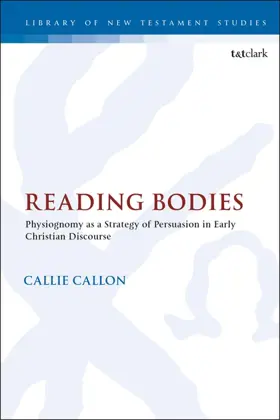

Reading Bodies: Physiognomy as a Strategy of Persuasion in Early Christian Discourse
in Library of New Testament Studies
Pages
192
Publisher
T&T Clark
Published
1/10/2019
ISBN-13
9780567684387
Callie Callon investigates how some early Christian authors utilized physiognomic thought as rhetorical strategy, particularly with respect to persuasion. Callon shows how this encompassed denigrating theological opponents and forging group boundaries (invective against heretics or defence of Christians), self-representation to demonstrate the moral superiority of early Christians to Greco-Roman outsiders, and the cultivation of collective self-identity (particularly in martyrologies).
The work begins with an overview of how physiognomy was used in broader antiquity as a component of persuasion. Callon then examines how physiognomic thought was employed by early Christians and how physiognomic tropes were employed to “prove” the orthodoxy and moral superiority of early Christians by early Christians. Building on the conclusions of the earlier chapters, Callon then focuses on the representation of the physiognomies of early Christian martyrs, before addressing the problem of the acceptance or even promotion of the idea of a physically lacklustre Jesus by the same authors who otherwise utilize traditional physiognomic thought.
The work begins with an overview of how physiognomy was used in broader antiquity as a component of persuasion. Callon then examines how physiognomic thought was employed by early Christians and how physiognomic tropes were employed to “prove” the orthodoxy and moral superiority of early Christians by early Christians. Building on the conclusions of the earlier chapters, Callon then focuses on the representation of the physiognomies of early Christian martyrs, before addressing the problem of the acceptance or even promotion of the idea of a physically lacklustre Jesus by the same authors who otherwise utilize traditional physiognomic thought.
- Table of contents
- Acknowledgments
- 1. Introduction:
- 2. Chapter One: Overview of Ancient Physiognomy and the State of the Question
- 3. Chapter Two: The Physiognomy of a Heretic: Physiognomic Polemic as a Component of Persuasion in Demarcating "Insiders" and "Outsiders".
- 4. Chapter Three: The Physiognomy of the (Ideal) Early Christian.
- 5. Chapter Four: The Physiognomy of a Martyr.
- 6. Chapter Five: “He Had Neither Form Nor Beauty”: The Physiognomic Curiosity of The Negative Descriptions of the Physical Appearance of Jesus and their Respective Roles in the Rhetoric of Persuasion.
- 7. Conclusions
- Index